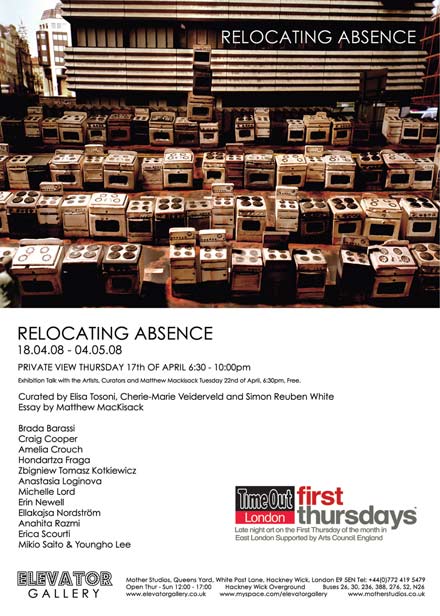
Group exhibition showcasing the work of thirteen internationally emerging artists. Through a variety of media, including sculpture, installation, video, photography and drawing, the exhibition offers a series of artistic interpretations of the theme, often playing with the constants of space and time. Absence, in fact, is essentially temporal – it is located where something was: it lies between the realms of Being (object) and Knowledge (perception, creation of a mental image).
18 April – 4 May 2008
PRIVATE VIEW Thursday, 17 April, 6.30 - 10 pm
Exhibition Talk with the artists, curators and writer on Tuesday, 22 April, 6.30 pm. Free.
Opening hours: Thursday - Sunday 12 am - 5 pm
Elevator Gallery,Mother Studios, Queens Yard, White Post Lane,
Hackney Wick, London E9 5EN
Absence can be intended as a state of being, as a period of time, as a lack, or even desire, or as the inattention to present surroundings or occurrences. All these connotations are encountered in the exhibition, which, in fact, proposes an open-ended investigation of the concepts of belonging, displacement, repetition, visual and literary narrative, emotional and physical distance, as well as archive, memory and diary keeping.
The artists have created presence from absence, erased the pre-existent iconography of presence, drawn the viewers’ gaze to details that would otherwise have remained long unnoticed. These acts of relocating, of replacing, collecting or remembering what was there continue absence into the future: new tangible objects now substitute or relocate a previous absence, soon to leave room to new absences, in the viewer’s mind.
Brada Barassi presents Sei sempre appena andata via (You Have Always Just Gone Away), a video installation exploring the relationship between being, memory and distance through a series of photographs, combined with sound. The images were taken across two countries (UK and Italy) in the space of three years, and the narration is bilingual. The piece questions one’s connection to the idea of belonging through a feeling of displacement, and the interplay of the constants of time and space.
Craig Cooper exhibits a series of roadwork signs, where the informative panels have been removed and substituted with sheets of glass. Devoid of their visual lexicon, they become abstract objects characterized by their own aesthetics, on the boundary between sculptural and painterly. A similar abstraction is shown in Cooper’s maps, where the erasure of text leaves room to a sequence of new grids and thick black lines, denying the initial function of the map as a navigation tool.
Amelia Crouch’s Looking- Capture- Reproduction, a fragmentary narrative in scenes, consists of a series of eight short texts printed on paper and pasted to the wall. Each text is highly evocative of an absent visual image, that the viewer is invited to relocate in his own mind, drawing on his personal visual archive.
Hondartza Fraga exhibits a site specific installation, Incandescent, where the contrast between a series of light bulbs and their skillfully drawn shadows recalls the dichotomy of absence and presence. The perfect miniature scenarios depicted in the shadows become promises that can never be fulfilled, pointing out the isolation and imperfection of the reality they evoke.
Zbigniew Tomasz Kotkiewicz’s The Swimmer is suggestive of an invisible narrative, through the image’s compositional elements as well as the irony of the title. The absence of a figure contrasts starkly with the traces of a human presence, triggering the viewer’s curiosity and visual memory.
Anastasia Loginova’s black and white photographs depict an enchanted girl wrapped in a clear plastic bag, her facial expression frozen. A delicate, almost ethereal narrative frames the suspended gestures of the subject, making them timeless, almost lost.
Michelle Lord exhibits Future Ruins, a series of photographs inspired by J. G. Ballard’s apocalyptic literary fiction, which Lord relocates in Birmingham, using hand made models and rear screen projections. The inhabitants of the city are absent, and familiar, concrete urban structures become occupied by strange assemblages, built from the technological detritus of abandoned television sets, computers and domestic appliances. The images aim to highlight the temporality of landscape, reflecting on lost or ephemeral urban architectures.
Erin Newell’s A Map of the Ocean between my Sister & Me is an unusual record for emotional and physical distance through a personal journey. A collection of water samples from the ocean, this highly intimate archive is presented in a display case - each sample labeled - establishing a connection between a traditional museum display and the exposure of personal memories.
Ellakajsa Nordström exhibits Window View, a multimedia installation documenting one year of performative recordings of the view from her studio’s window, facing the backyard of a row of houses. A collection of detailed diary writings, photographs, video and sound recordings - as well as documentation of performances as a means to explore the view and the artist’s relationship to it - the piece explores the dualism between absence and presence, and questions the realms of narrative, time, space and diary keeping.
Anahita Razmi’s Fall is a participatory installation entailing the viewer to become a sculptural form, crawling into a sleeping bag where a video of a “downfall” in a tube slide is shown. This upside down continuous fall generates in the viewer a strong feeling of displacement, as if he was falling upwards.
Erica Scourti’s Spectrum is a projection of digitally manipulated photographs of world-wide protests and marches, from which the artist has erased all text on banners. Instead of carrying meaning and proclaiming the bearers’ beliefs, the banners turn into colourful, sculptural and painterly objects. Furthermore, being archived according to colour, they become totally abstracted from any political credo.
Mikio Saito and Youngho Lee collaborate as an artists’ duo. Alternating their drawing act, while brainstorming and discussing inspired by the exhibition’s title, they have created a large drawing installation especially for Relocating Absence. They introduce the viewer to a new visionary landscape, populated by a magical cast of characters: a skillfully directed doodling, devoid of narrative, yet suggestive of a million microcosms.
Elisa Tosoni, 2008






